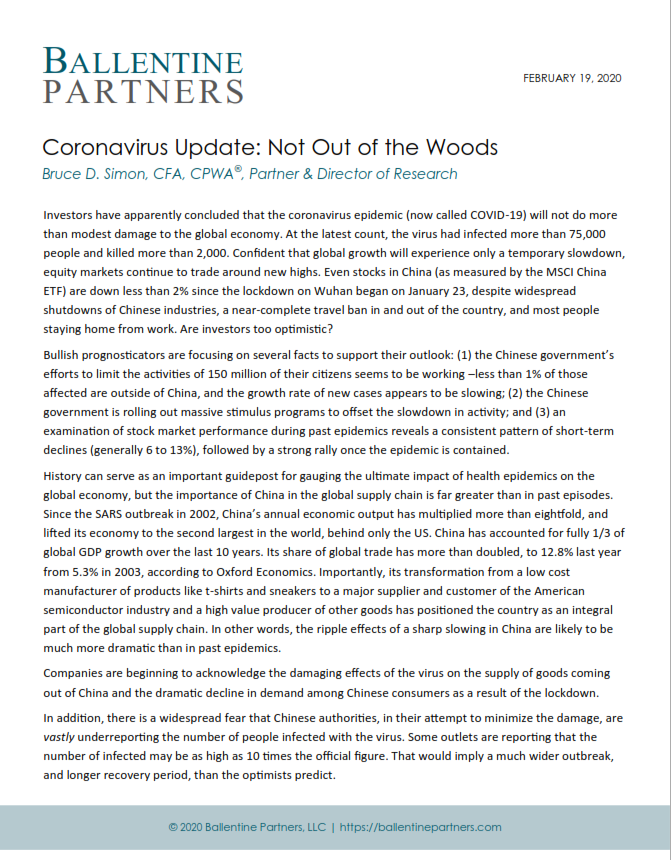Investors have apparently concluded that the coronavirus epidemic (now called COVID-19) will not do more than modest damage to the global economy. At the latest count, the virus had infected more than 75,000 people and killed more than 2,000. Confident that global growth will experience only a temporary slowdown, equity markets continue to trade around new highs. Even stocks in China (as measured by the MSCI China ETF) are down less than 2% since the lockdown on Wuhan began on January 23, despite widespread shutdowns of Chinese industries, a near-complete travel ban in and out of the country, and most people staying home from work. Are investors too optimistic?
Bullish prognosticators are focusing on several facts to support their outlook: (1) the Chinese government’s efforts to limit the activities of 150 million of their citizens seems to be working –less than 1% of those affected are outside of China, and the growth rate of new cases appears to be slowing; (2) the Chinese government is rolling out massive stimulus programs to offset the slowdown in activity; and (3) an examination of stock market performance during past epidemics reveals a consistent pattern of short-term declines (generally 6 to 13%), followed by a strong rally once the epidemic is contained.
History can serve as an important guidepost for gauging the ultimate impact of health epidemics on the global economy, but the importance of China in the global supply chain is far greater than in past episodes. Since the SARS outbreak in 2002, China’s annual economic output has multiplied more than eightfold, and lifted its economy to the second largest in the world, behind only the US. China has accounted for fully 1/3 of global GDP growth over the last 10 years. Its share of global trade has more than doubled, to 12.8% last year from 5.3% in 2003, according to Oxford Economics. Importantly, its transformation from a low cost manufacturer of products like t-shirts and sneakers to a major supplier and customer of the American semiconductor industry and a high value producer of other goods has positioned the country as an integral part of the global supply chain. In other words, the ripple effects of a sharp slowing in China are likely to be much more dramatic than in past epidemics.
Companies are beginning to acknowledge the damaging effects of the virus on the supply of goods coming out of China and the dramatic decline in demand among Chinese consumers as a result of the lockdown.
In addition, there is a widespread fear that Chinese authorities, in their attempt to minimize the damage, are vastly underreporting the number of people infected with the virus. Some outlets are reporting that the number of infected may be as high as 10 times the official figure. That would imply a much wider outbreak, and longer recovery period, than the optimists predict.
The International Monetary Fund expects global economic activity to moderately strengthen in 2020 after a marked slowdown in 2019. But in a nod to the two handed economist theory, (“on the one hand……”), they note that “downside risks to the outlook continue to dominate”.
While we remain optimistic that the spread of the COVID-19 virus will ultimately be contained with little long-term damage to the global economy, the near-term impacts are still quite uncertain. Even Fed Chairman Powell noted in his recent testimony to Congress that he has little confidence in the range of assessments being put forth by various experts. In our view, it is too soon to declare an all-clear for the global economy.
Data as of February 19, 2020
Learn more about Bruce Simon, our Director of Research.
This report is the confidential work product of Ballentine Partners. Unauthorized distribution of this material is strictly prohibited. The information in this report is deemed to be reliable but has not been independently verified. Some of the conclusions in this report are intended to be generalizations. The specific circumstances of an individual’s situation may require advice that is different from that reflected in this report. Furthermore, the advice reflected in this report is based on our opinion, and our opinion may change as new information becomes available. Nothing in this presentation should be construed as an offer to sell or a solicitation of an offer to buy any securities. You should read the prospectus or offering memo before making any investment. You are solely responsible for any decision to invest in a private offering. The investment recommendations contained in this document may not prove to be profitable, and the actual performance of any investment may not be as favorable as the expectations that are expressed in this document. There is no guarantee that the past performance of any investment will continue in the future.




